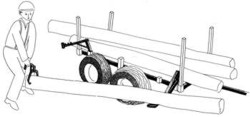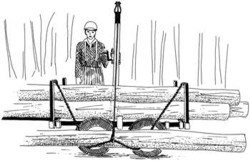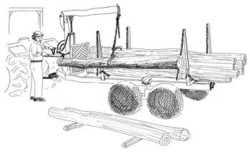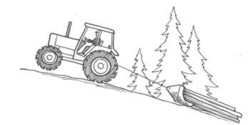Lesson Six - Forwarding
Forwarding is when both ends of the log are off the ground while being transported. This lesson focuses on various ways of loading trailers and forwarding with a trailer. Safe forwarding tips when using an ATV or tractor are also covered.
The logs are forwarded to where they will be picked up or processed. To reduce the forwarding distance, you can also take a portable sawmill or wood splitter to the piled wood.
LOADING YOUR TRAILER
 |
| 6.1 Loading a trailer by hand using leverage |
A trailer can be loaded by hand, with a manual or hydraulic powered winch or with a loading boom. What's right for you depends on the size and amount of wood you plan to cut. Grapple loaders are also used though they are expensive and more suited to high production.
Loading using leverage
This trailer has a lower and upper support for the log. Once the log is balanced on the upper support, pivot it into the trailer. When the trailer is full, attach the load to the frame with a chain and tighten it with a straight pole or use a load binder. Using leverage like this lets you load and unload 136 kg (300 lb) logs by hand.
 |
| 6.2 A Manual winch doesn't cost much and makes loading easier |
Loading with a manual winch
The manual winch can load logs up tp 545 kg (1,200 lb). Once the trailer is full, tighten the chain only around the load and frame using the winch and cable. To unload, attach unloading poles to the trailer stakes. Slide the cable under the log, lift it and let it roll down the poles. This is called parbuckling.
Example A
Abdul has an ATV and is skidding big sawlogs with a Yankee Yarder winch. He now needs to forward the logs out. Sawlogs are heavy to load so he decides to get a trailer with a manual loading winch.
Loading boom
This system consists of a pivoting mast and a boom with a hook on the end. A chain with a lifting tong on the end goes through the hook. This loader is powered by hydraulics from the tractor. Reusable stakes on the side keep the load in.
 |
| 6.3 A loading boom may be the good choice for a tractor if you have a higher volume than you want to load by hand |
Before loading, remove the side stakes but place them back before the load gets too big to do so. To load the trailer, the lifting tong is attached to the middle of a log on the pile. The boom is lifted and the operator balances the log using a pickanon (log pick). You can load several small logs using a choker.
The load is fastened with a chain that goes around the load so put it on the trailer before you begin. Chains also go across the load from stake to stake.
The trailer can be unloaded in a couple ways. You can use the boom and take the logs off one or two at a time. Or the logs can be dumped all at once by tilting the load. This is done with a tilting cross beam raised by the boom on one side while the chained load moves the stake and falls out on the other.
Example B
Remember Pauline and Bill from Lesson Five who are going to buy a tractor and skidding winch for their planned harvest of 80 cords?
They will have many small piles of wood along their skid roads and trails that need to be forwarded to create a big pile on their skid road for pickup. They will need some kind of aid to load the trailer for that much wood. They plan to buy a trailer with a hydraulic boom loader to load and unload the log piles.
SAFE FORWARDING
While modifications like chains, extra weight and ROPS may help, it is best to practice safe forwarding techniques to prevent an accident in the first place. Don't overload the trailer and try to balance the load. Also leveling off hummocks and filling in holes on the trail will make forwarding safer.
Balancing the load on an ATV
! Balancing the load on your trailer will keep you safe and on track.
If the load is too heavy at the back:
- ATV rear wheels rise up
- ATV looses traction and jack knifes
If the load is too heavy at the front:
- ATV rear gets pushed down
- ATV rolls over backwards
To check balance, lift up on draw bar, note resistance and readjust load as needed. The hitch should move easily up and down with little weight on the ATV from the trailer. Going up hill or down also changes the balance. The weight on the hitch will lessen going up hill and increase going down.
Balancing the load on a tractor
Balance the load on the trailer so that no more than 1/3 is on the draw bar. The balance can affect the traction and steering. Place logs so that butt ends alternate between the front and back and make sure the load is tight.
Slopes and curves
The main concern with forwarding is controlling the load on slopes and on curves. When going uphill with a trailer, choose one gear if possible and use that until you get to the top. Changing gear can cause a rear roll over. When going down, select a low gear that lets you use engine compression to maintain a slow speed. Try not to turn while going downhill. If you have to, be careful that the rear wheels don't swing out and jack knife the machine.
Improved braking on an ATV
As mentioned in Lesson Three, ATV brakes are not designed for forwarding a trailer of logs. Some extra precautions can be used to improve braking when going downhill with a load. These are: reduce the load, install traction chains on the rear wheels of the ATV, and drag a log behind the trailer.
For occasional use, you can also install a section of snowmobile track under the rear wheels tied to the walking beam of a bogie wheel trailer. See Appendix B for Web sites.
SAFE DRIVING
- Change gears slowly
- Depress clutch if front wheels lift up
- Use low gear going downhill
- Do not shift going uphill (automatic ATVs may be safer for this reason)
- Brake gently/ brakes can be used to help steer
- Take turns at low speeds
- Wear a seatbelt
To prevent side rollovers:
 |
| 6.4 A tractor can back flip if the load gets stuck |
- Avoid driving across a slope with a loaded trailer. If you have to, take a small load.
- Avoid turns at the top of a slope.
- Avoid ditches.
To prevent rear rollovers:
- Distribute the tractor-load weight evenly
- Watch out for obstacles
- Start slowly and let clutch out gradually
Further reading on forwarding .....
Using an All-Terrain Vehicle To Produce Long-Length Logs is a basic guide to forwarding with an ATV.
Using a Farm Tractor To Produce Long-Length Logs provides a basic guide to forwarding with a tractor.
Forestry Implements for the Farm Tractor, Supplement to FERIC Handbook #11 has more on trailers.
Specific models of trailers and company contacts are provided in Small Scale Woodlot Equipment, a binder produced by the Maritime Woodlot Extension Committee.
See Appendix A.